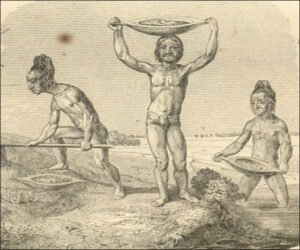Queen Isabella and King Ferdinand’s instructions to Columbus at the commencement of the second voyage required that all trade with “Indians” be conducted by barter. In practice, the key barter envisioned was trading items such as hawks’ bells, bead necklaces, and clothing for food and gold jewelry or raw gold, with all gold items becoming the sovereigns’ property.
Following the battle of Santo Cerro, Columbus ended the practice of barter and instituted a system of “tribute,” whereby each chieftain living in areas of “Española” then subjugated was required to collect from his subjects fourteen years or older a hawks’ bell of gold every three months for payment to Columbus (i.e., as if a tax, without barter in return), the gold becoming the sovereigns’ property.
As depicted in Columbus and Caonabó, Columbus imposed tribute first on Chief Guarionex and—from May through the summer of 1495—he and his brother Bartolomé traveled in the subjugated areas forcing it on other chieftains (528 years ago). Tribute’s imposition contributed to the decline in Taíno population that accelerated on Española in 1495, as Taínos were forced to pan or dig for gold rather than farm, hunt, or fish, thereby resulting in crop failure and famine. The gold jewelry and other ornaments they relinquished constituted cherished ancestral heritage.
The following engraving (included in Columbus and Caonabó) shows Taínos gathering gold tribute, taken from Oviedo’s Historia General, 1535, lam. 2.

